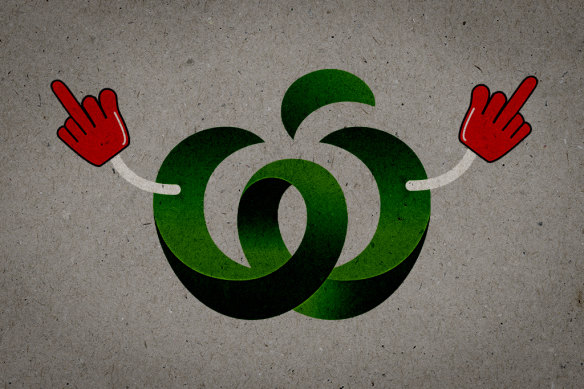Opinion
An RBA focused on real cost-of-living pressures? That’s bananas
Shane Wright
Senior economics correspondentBack in 2006, when Ian Macfarlane was at the helm of the Reserve Bank of Australia, a Liberal MP asked what the impact of a spike in banana prices had on the RBA’s decision to lift official interest rates.
At the time, inflation had jumped 1.6 per cent in the June quarter, taking the overall inflation rate to 4 per cent. The big lift was due, in part, to a 400 per cent surge in banana prices after Cyclone Larry had effectively wiped out the East Coast’s supply of the lunchbox favourites.

Credit: Illustration: Simon Letch
Where you could find them, bananas were going for around $15 a kilogram - up from $2 a kilo before Larry. Of course, most supermarkets couldn’t get their hands on any, so the prices for non-cyclone affected fruits like oranges, apples, melons and strawberries lifted as consumers bought substitutes.
Newspapers and television news were full of reports about the so-called banana interest rate hike. But Macfarlane made it clear that any suggestion that the central bank was changing the cash rate just because of bananas was, well, bananas.
“We knew long before this CPI came out everyone was going to be talking about bananas. We actually know what the price of bananas is,” Macfarlane declared.
To date, it remains the only time a Reserve Bank governor has discussed bananas, inflation and interest rates in the same sentence. But new research published by the Bank of England last week suggests that perhaps Macfarlane should have been worried after all.
Unflatteringly, the paper shows that the Bank of England and other central banks have been wrong when it comes to understanding how consumers look at and experience inflation.
Central banks glide above us, looking at pockets of inflationary pressure in the darkest and most obscure parts of the economy. In the past year alone, the RBA has cited hairdressers, dentists, the rental market and Taylor Swift as sources of inflation.
But the Bank of England research shows that everyday people see inflation in one place – the supermarket aisle.
According to the researchers, almost two-thirds of Britons said food prices was the key way they determined overall price changes over a 12-month period. And so long-lived is the impact of food-led inflation, the research shows that even when prices do retreat, people still feel inflation is climbing.

Artwork: Marija ErcegovacCredit: Marija Ercegovac
Controversially, the researchers suggest central banks have got their focus on “core inflation” wrong, and that by focussing on this, the banks are missing out on what consumers really think.
This is a term we’ve all heard. Core inflation is the measure of inflation that takes out one-off big increases or falls. It’s an artificial creation of central banks that have sought to understand what they perceive to be the real drivers of inflation, and is one RBA Governor Michele Bullock says she and the board want to see falling in Australia.
But, as the researchers found, “monetary policy should respond more aggressively to food price shocks, which calls for a re-evaluation of the emphasis that is given to measures of core inflation as a guide to monetary policy decisions”.
In layman’s terms, if central bankers took account of inflation as it’s felt by ordinary punters, rather than creating artificial measures of underlying inflation, they’d have a much better idea of the price pressures across the economy.
So, during the great bananapocalypse of 2006, perhaps the RBA should have lifted interest rates more aggressively than it did (the earlier 5.75 per cent lift went up to 6.25 per cent later in the year). And, when fruit and veg prices fell (as they did in 2012), the bank should have cut rates more aggressively.
Perhaps central bankers should take a leaf out of the book of politicians, who understand retail inflation particularly well.
Just look at the debate about supermarkets, where the Coalition has been agitating about prices for months, with even pro-business Liberals backing a “last-resort” policy of breaking up the supermarket giants caught in price-gouging, and the government has poured money into the Australian Competition & Consumer Commission so that it can better target supermarkets.
The ACCC has launched legal action against Coles and Woolies, prompting Anthony Albanese to accuse the supermarket giants of adding to inflation pressures. The prime minister is also leading the charge against “shrinkflation” – a concept every shopper knows about, but which central banks rarely mention.
Both sides of politics understand that what goes on in the aisles of our supermarkets affects the perceptions of voters to a whole host of issues, including the cost of living.
The most recent quarterly measure of inflation had overall prices up by 3.8 per cent and underlying inflation up by 3.9 per cent. But in the supermarket aisles, inflation was much lower at 3.3 per cent, and would have been even lower if not for a weather-related spike in the prices of apples and watermelons.
If the Bank of England researchers are right, the RBA would do well to be more focused on what people are doing in response to those high-priced apples and melons. God forbid what it should do if we lose another banana crop.
Shane Wright is a senior economics correspondent.
The Opinion newsletter is a weekly wrap of views that will challenge, champion and inform your own. Sign up here.